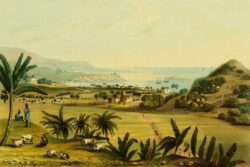Transfer of Souls
Erna Brodber’s Louisiana
Published: May 31, 2022
Last Updated: August 30, 2022

Wikimedia Commons
An idealized view of St. Mary Parish, Jamaica, ca. 1825, illustrated by James Hakewill for A Picturesque Tour of the Island of Jamaica.
Cue tape: The date is November 10, 1936. Location: the Bayou Teche town of Franklin, St. Mary Parish, Louisiana. Subject: Ella Townsend in conversation with Sue Ann Grant-King, recording an oral history under the auspices of the Works Progress Administration. And roll tape: “What we want to know . . . is what life was like for you,” Ella Townsend speaks into her voice recorder early on in Erna Brodber’s Louisiana, a surreal, splendid short novel written in the form of an oral history transcript and notes. “Tell me all about Louisiana,” she says. “Tell me anything, everything.”
Sue Ann is “a most original story-tell,” according to Ella’s superiors in the WPA. “This woman they say has important data to give; is important data,” Ella writes in her pre-interview notes. “She has seen things; had done things; her story is crucial to the history of the struggle of the lower class negro that they [the WPA] want to write. I was chosen to do her.” Despite complications of race, class, and power in this documentary project of Black voices, Ella acquiesces.
“Because of my colour,” Ella believes, “I could get her to talk.”
But Sue Ann demurs. She stalls, shuffles cards, tells nothing, instead posing questions, pulling details—anything, everything—from her interviewer.
Ella is a Zora Neale Hurston–esque writer and Columbia University anthropology student originally from a small Jamaican village named Louisiana, in Saint Mary Parish—the same birthplace, she would discover, of Sue Ann’s beloved, departed friend Louise (not to mention the author, Erna Brodber).
Two Louisianas, two Saint Mary Parishes—glory be such synchronicity! This gets Sue Ann talking on the similarities between the two lands, parallels she picked up from her friend Louise: “They have brass bands but not as good as ours; they have mento [a Jamaican folk dance], flat-footed shuffle like ours; . . . they have tobacco and some sugar cane but no cotton. They have bananas in banana trees like windmills.” Two parishes, too much the same: “You have no winter. But you have plenty rain just like us here. And sometimes hurricanes.”
And with that, Ella’s recorder clicks off. “One whole side gone,” she mutters to herself, an afternoon wasted, “and not a thing to give to the white people.” She hopes to continue the interview tomorrow.
But Ella awakes the next morning in a blur of disquietude, the voices of Sue Ann and Louise—“the venerable sisters,” she calls them—ringing in her head. “I was no longer just me,” she writes in her notes. “I was theirs. The venerable sisters had married themselves to me—given birth to me,—they would say. I could feel the change.” A neighbor brings news: Sue Ann has passed.
Days later, at Sue Ann’s funeral, Ella sees a vision, a youthful version of her oral history subject climbing a rainbow ladder across the sky, horizonward, and instantly falls into mouth-foaming convulsions. Ella’s reaction “was quite consistent,” witnesses would tell her later, “with the transfer of souls.”
The connections that bind the souls of the African Diaspora lie at the heart of Brodber’s Louisiana. The novel, her third, published in 1994, was “a book of books, shelved on top of each other with a stairway between,” she wrote in a 2012 essay. Louisiana, much like the state itself, acts as a combining of cultures, a re-migration of pan-African memory, a literal joining of bodies. Ella’s story is “a lecture to African Caribbean and African American people,” Brodber said. “I wanted to make the point that we have a long history of cooperating to produce a diaspora culture and it would suit us politically in the contemporary period to find our way back to each other and together to face problems that are so similar.” The novel is an attempt to say, in the author’s words, “Look, we’re the same thing.”
Ella terms this new feeling of diasporic connectivity the “hegemony of the spirit,” an ascendency of multiple souls. As she transcribes her recorded interview with Sue Ann, she hears voices on the tape, conversations between “otherworld people”—Sue Ann, Louise, and herself—that she did not hear in person. Now, finally, Sue Ann tells her story—not just anything, but everything. The lynching of her grandfather, her husband’s philandering, her involvement in the Garveyite Back-to-Africa movement. Ella learns all about Louisiana, both her own and the one that lies across a sea and a gulf, twelve hundred miles away.
The oral historian thus becomes the teller of tales. Ella resolves to remain in Louisiana, relocating to New Orleans instead of returning to New York. She listens to the Sue Ann recording again and again, channeling new voices, finding new details to add to the transcript, eventually falling in and out of a psychic coma.
At this point Brodber’s novel, like Ella’s state of mind, reads like a fever dream. “I am the link between the shores washed by the Caribbean sea,” Ella writes. “I am what joins your left hand to your right. I join the world of the living and the world of the spirits. I join the past with the present.” She embodies “two different women. Two different places. Two different times”—half Louise, half Sue Ann. “One sound. From one body. A community song,” she writes. “I am Louisiana.”
And with that, this oral history-as-novel, Ella-turned-Louisiana’s story, ends.
Rien Fertel’s next book, a history of humanity’s relationship with the brown pelican, will be published in September by Louisiana State University Press.
